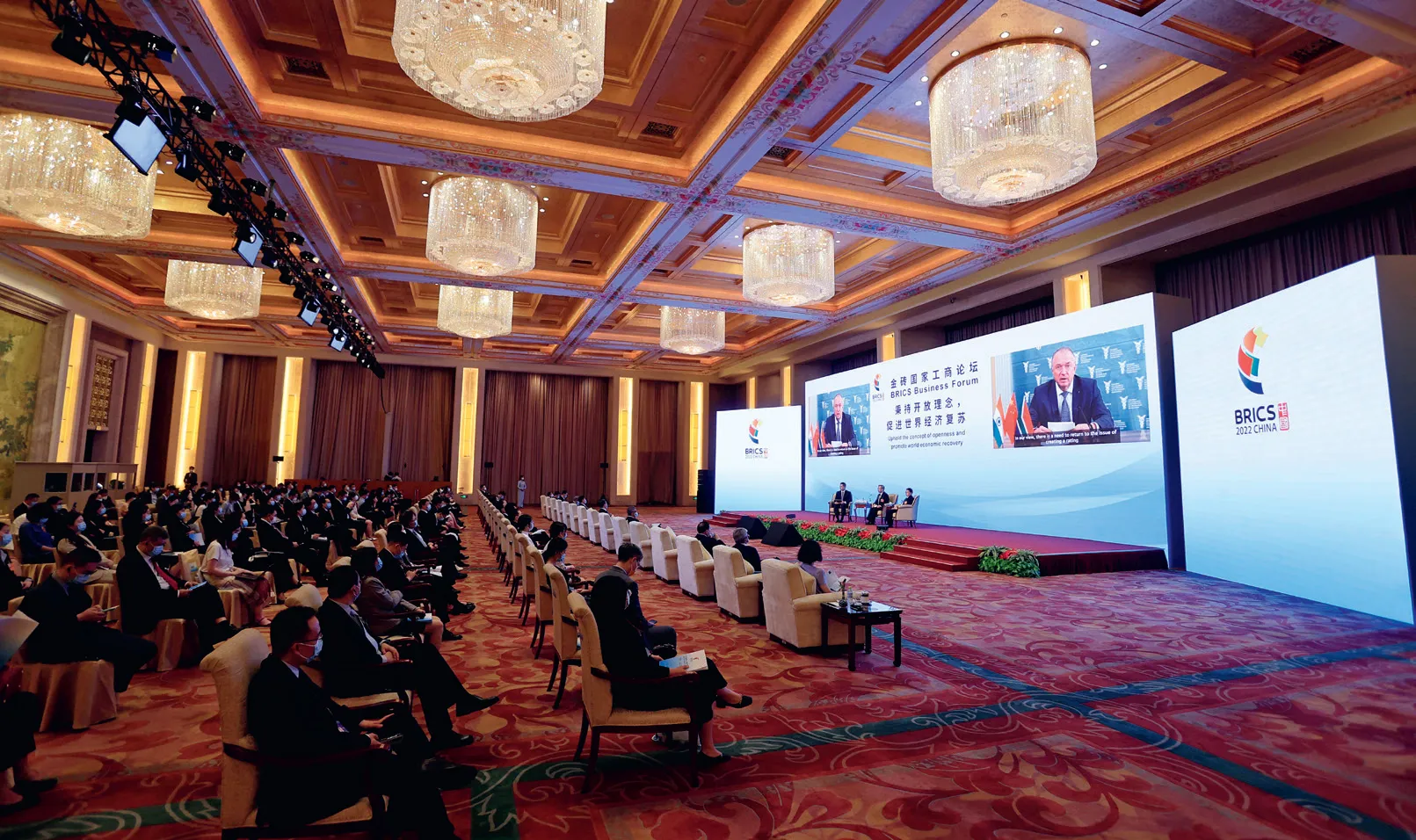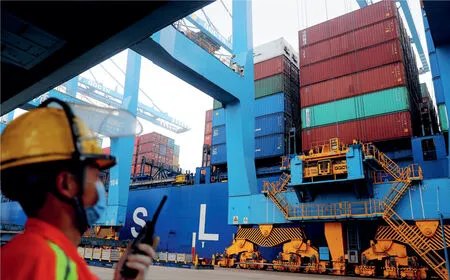BRICS Prevails over Blocs
By RADHA WARRIOR
The New Development Bank and other collaborations of BRICS show how pragmatism can overcome political differences.

A panel discussion with the theme “uphold the concept of openness and promote world economic recovery” is held during the BRlCS Business Forum in Beijing on June 22, 2022.
SOME people might be disappointed with the BRICS Summit held in June which produced no sensational news. Before that, U.S. President Joe Biden, with his Partnership for Global Infrastructure and Investment, announced a US $600 billion global infrastructure initiative guaranteed to grab all the headlines, but left behind the confusion about where all that money would come from.
When all that sensationalism has simmered down and even the other much-anticipated meeting, the NATO Summit in Madrid in late June, failed to deliver more sizzling content than its formal invitation to Finland and Sweden to become members of the club, perhaps this is a good time to review the BRICS Summit, as the saying goes, “Still waters run deep.” Though the annual meeting of Brazil, Russia, India, China, and South Africa attracted more than its usual share of attention this time because of Russia’s presence when it is being shunned on the global stage due to the Ukraine crisis, the actual tangible work the bloc has done went virtually unnoticed.
A rare exception was Brazilian Foreign Ministry official Ana Maria Bierrenbach, who listed three concrete results in the report released by the Brazilian Center for International Relations, a think tank in Rio de Janeiro. She called the New Development Bank (NDB), the BRICS bank founded in 2014 to fund infrastructure and sustainable development projects in the five member countries as well as other emerging and developing economies, “the greatest achievement of BRICS since its creation.” The other two were the recently launched vaccine research center and an agreement on customs facilitation for trade within the bloc.
The NDB is the crucial foundation on which the BRICS can build new economic tools. One prime reason is credibility.
Since it started operations in 2015 with an initial authorized capital of US $100 billion, the NDB has established itself as a lender with acceptance that goes beyond the bloc. While BRICS is still pondering over admitting new members, though several countries have shown interest, from Iran to Argentina, progeny NDB has acted faster, expanding to four new members last year – Bangladesh, the UAE, Uruguay, and Egypt.
Operation-wise, arguably its promptest work has been during the pandemic. BRICS members were able to get funds worth US $1 billion each from NDB’s COVID-19 emergency loan program, either for supporting healthcare response or economic recovery or both. It provided help near home instead of having to seek it at the door of the World Bank or IMF or other donors with preconditions attached.
The NDB is also BRICS’ bankable partner in achieving their sustainable development goals. To meet their announced goals of reducing emissions and increasing the use of clean energy, the NDB has been funding projects that range from a proposed one for solar lighting in Brazilian capital Brasilia, to already approved schemes for renewable energy development in Russia and ecotourism infrastructure in India’s northeastern underdeveloped Meghalaya state.
The BRICS Vaccine Research and Development Center Initiative, launched this year, is also a relevant project, especially with alerts of new pandemics. It is pooling research and epidemiological experiences from institutions of member countries to produce new vaccines in case of further pandemics, and increase the production of existing vaccines so that other developing nations can access them. The objective is to address “the vaccine apartheid.” Last year, the World Health Organization set a 70-percent target for global vaccination coverage, which should have been attained by June this year. But only 58 of its 194 member states met the target. Especially in many African countries, only around 20 percent of the population or even less had been vaccinated.
BRICS is also supporting a temporary waiver of patents on vaccines to tide over the vaccine chasm between developed and developing nations, and the R&D center, while virtual at present, will also support setting up local vaccine production centers in collaboration. However, this is a new initiative and will need time to establish itself and earn trust internationally. In that respect, the NDB has a headstart.
The current geopolitical situation has shown once again the importance of something BRICS has been mulling for a long time: a BRICS cross-border payment system and a BRICS credit rating agency or alliance of agencies.
Currently, three Western credit rating agencies dominate the industry – Fitch, Moody’s, and Standard and Poor’s. However, there are issues of trust here. One complaint is that some of the negative assessment of developing economies made by them were not fair but swayed by political or other interests. During the 2008 financial crisis, their wrong or motivated assessments came to light. Moody’s alone, for example, reportedly agreed to pay over US $800 million to settle with U.S. federal and state authorities over its ratings of risky mortgage securities. Collectively, the rating agencies paid over US $2 billion in fines.
Several BRICS members allege they were unfairly assessed due to politics and Western hostility to their governments. On the other hand, they all have their domestic credit rating agencies. However, these agencies lack wider recognition. So BRICS can develop a new agency from scratch or form an alliance of the existing ones. One key challenge they will face is skepticism from Western investors. However, if the NDB throws its weight behind such an agency, its gravitas is bound to increase.

A cargo ship bound for South Africa is being loaded with containers on June 22, in the Qingdao area of China (Shandong) Pilot Free Trade Zone.
The same thing goes for a crossborder payment scheme. The bid to disconnect Russian banks from the global online payment system SWIFT in the wake of the Ukraine crisis shows the desirability of having alternatives. With the uncertainties in geopolitics, who knows but more BRICS members could face a similar predicament, especially if the Western insistence that they condemn Russia grows.
Besides, there’s a positive factor to consider as well – the rapid growth of e-commerce. In 2020, according to a BRICS business report, global businessto-business e-commerce transactions alone were worth about US $7 trillion. By 2027, they are expected to grow by over 17 percent. With customs procedures standardized, a uniform transaction currency and payment system would galvanize BRICS trade.
A lot of work is already going on in China’s port city Xiamen, which hosted the 2017 BRICS Summit. In 2020, the BRICS Partnership on New Industrial Revolution Innovation Center was set up there to provide a foothold for BRICS organizations and businesses to make use of digital and other high technology such as artificial intelligence, blockchain, and big data. Now it has been proposed that such centers be established in other member countries as well.
How can they help boost trade? This year, the China International Fair for Investment and Trade, the largest global investment fair held annually at Xiamen, included an online platform exclusively for products from BRICS countries. It was supported with an offline platform at the Xiamen cross-border ecommerce industrial park, where over 700 products were showcased. Xiamen is already piloting digital innovation for cross-border trade. If this is replicated in other BRICS member countries, their trade would gather steam.
The NDB is already in this picture. It signed an agreement with the Xiamen innovation center this year to cooperate in several areas, from AI to energy conservation.
But perhaps the most remarkable achievement of the NDB – as well as BRICS – is pragmatic cooperation despite political differences. India and China, the two biggest economies in the bloc, have ups and downs in their bilateral relationship, including military clashes. And India is also a member of the Quadrilateral Security Dialogue that also consists of the U.S., Japan and Australia and is regarded by China as an initiative to contain it. However, that has not prevented India and China from putting their heads together in consultation in BRICS and reaching consensus. Neither has it resulted in the NDB lending more to one and less to the other.
At a time when the world is breaking up into blocs hostile to one another, this remains a good example to keep in mind.

